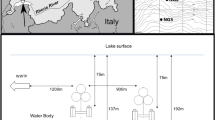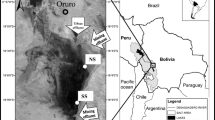Abstract
Seasonal and regional variations in the speciation, sediment-water partitioning, and dynamics of mercury (Hg) were studied at selected sites along the Hg-polluted Wabigoon River, and at unpolluted headwater and tributary sites, during April–September, 1979. ‘Dissolved’ and ‘particulate’ forms of Hg in the water were separated by continuous-flow centrifugation in the field. The Hg and other pollutants such as wood chips and salt had been discharged from a chlor-alkali plant and paper mill at Dryden, Ontario.
Concentrations and loadings of particulate methyl mercury (CH3Hg+) and total particulate Hg (and loadings of total ‘dissolved’ Hg) were greatest during the spring flood (April-May) owing to accelerated resuspension and transport of sediments. Concentrations of ‘dissolved’ CH3Hg+, however, were highest in the summer (July–September), probably reflecting stimulation of microbial methylating activity by elevated temperatures, together with factors such as reduced levels of metal-scavenging particulates and minimal dilution by runoff. Total dissolved Hg concentrations were relatively high in September at polluted sites only, possibly because of desorption from sediments due to elevated concentrations of Cl− ions. Loadings of dissolved CH3Hg+ tended to be high in the summer but were generally depressed (suggesting sorption by suspended particles) during the major spring-flood episode in May.
During July–August dissolved CH3Hg+ was a function of total dissolved Hg, suggesting rapid biomethylation of desorbed inorganic Hg; but in general dissolved and suspended CH3Hg+ levels depended on environmental variables and were unrelated to total Hg concentrations. In the summer only, total dissolved Hg was a function of dissolved Cl−. Hg species in particulates were associated with sulfides, hydrated Fe and Mn oxides, organic matter (notably high molecular weight humic and humic-Fe components), and selenium (Se); but CH3Hg+ and total Hg differed in their specific preferences for binding agents, implying that binding sites discriminate between CH3Hg+ and Hg2+ ions. CH3Hg+ was associated with sulfide and (in the spring only) with Fe oxides, whereas total Hg was associated with organic matter and Se and with DTPA- and NaOH-extractable Fe in the spring but with Mn oxide and NaOH-extractable organics in the summer. Sulfides were most abundant in May, indicating that they were eroded from bottom sediments, but Fe and Mn oxides were most abundant in the summer, probably owing to activities of filamentous iron bacteria and other micro-organisms.
Particulate Hg was 98–100% nonextractable by mild solvents such as Ca acetate, CaCl2, dilute acetic acid, and (at polluted sites only) DTPA solutions, suggesting that the particulate Hg mobilized in the spring may not be readily available to organisms; association with Se and high molecular weight humic matter also supports this hypothesis. Hg probably becomes more bio-available in the summer, as suggested by the upsurge in dissolved CH3Hg+ and total dissolved Hg levels, and by increases in the solubility of particulate Hg in acetic acid, DTPA, H2O2, and NaOH solutions, as well as an increase in the relative importance of lower molecular weight fractions of NaOH-extractable Hg (in September).
Regional variations in Hg speciation and partitioning reflected a gradient in sediment composition from wood chips near Dryden to silt-clay mud further downstream. Hg in silt-clay mud relatively far (> 35 km) downstream from the source of pollution or in unpolluted areas appeared to be more readily solubilized by Cl− ions or chelators such as DTPA, more readily methylated (as indicated by downstream increases in dissolved CH3Hg+ levels and CH3Hg+/total Hg ratios), and was to a greater degree organically bound (H2O2-extractable), and thus was probably more bio-available, than Hg in wood-chip deposits. Possible explanations include weaker binding of Hg by the mud, the more finely divided state of the mud, and improved microbial growth at lower concentrations of toxic pollutants. Owing to enrichment in sulfides and Fe oxides, resuspended wood-chip sediments were especially efficient scavengers of CH3Hg+.
The results indicate that in any pollution abatement plan aimed at lowering the Hg levels in the biota of lakes fed by the Wabigoon River, immobilization, removal, or detoxification of dissolved as well as particulate forms of Hg in the river would probably have to be considered. Possibly, Hg species could be ‘scrubbed’ from the river water by increasing the suspended load and by sedimentation and treatment with Hg-binding agents in special receiving basins.
Similar content being viewed by others
References
Armstrong, F. A. J. & Hamilton, A. L., 1973. Pathways of mercury in a polluted Northwestern Ontario Lake. In: Singer, P. C. (Ed.) Trace Metals and Metal-Organic Interactions in Natural Waters, pp. 131–156. Ann Arbor Science Publishers.
Banoub, M. W., 1972. A method for the determination of particulate organic nitrogen in natural waters. Int. J. envir. analyt. Chem. 2: 107–112.
Beck, A. E., 1980. 1978 mercury levels in fish and sediments of the Assiniboine, Red, and Winnipeg Rivers. Report of the Manitoba Dept. of Consumer & Corporate Affairs & Environment (Environmental Management Div.). 39 pp.
Bishop, J. N. & Neary, B. P., 1976. Mercury levels in fish from Northwestern Ontario, 1970–1975: Report of Laboratory Services Branch, Ontario Ministry of the Environment. 84 PP.
Chao, T. T., 1972. Selective dissolution of manganese oxides from soils and sediments with acidified hydroxylamine hydrochloride. Soil Sci. Soc. Am. Proc. 36: 764–768.
Chester, R. & Hughes, M. J., 1967. A chemical technique for the separation of ferro-manganese minerals, carbonate minerals and adsorbed trace elements from pelagic sediments. Chem. Geol. 2: 249–262.
Feick, G., Johanson, E. E. & Yeaple, D. S., 1972. Control of mercury contamination in freshwater sediments. Report No. EPA-R2–72–077. U.S. Environmental Protection Agency. 160 pp.
Fimreite, N. & Reynolds, L. M., 1973. Mercury contamination of fish in Northwestern Ontario. J. Wildlife Management 37: 62–68.
Follett, R. H. & Lindsay, W. L., 1971. Changes in DTPA-extractable zinc, iron, manganese, and copper in soils following fertilization. Soil Sci. Soc. Am. Proc. 35: 600–602.
German, M. J., 1969. Water pollution survey of the Wabigoon River. Report of the Ontario Water Resources Commission. 24 pp.
Gupta, S. K. & Chen, K. Y., 1975. Partitioning of trace metals in selective chemical fractions of nearshore sediments. Environ. Lett. 10: 129–158.
Jackson, M. L., 1956. Soil chemical analysis- advanced course. Dept. of Soils, College of Agriculture, University of Wisconsin (Madison), 894 pp.
Jackson, T. A. (Ed.), 1980. Mercury pollution in the Wabigoon-English River system of Northwestern Ontario, and possible remedial measures: a progress report. Published by Government of Canada (Dept. of the Environment) and Government of Ontario (Ministry of the Environment). 139 pp.
Jackson, T. A., Kipphut, G., Hesslein, R. H. & Schindler, D. W., 1980. Experimental study of trace metal chemistry in softwater lakes at different pH levels. Can. J. Fish. aquat. Sci. 37: 387–402.
Jackson, T. A. & Woychuk, R. N., 1980a. The biogeochemistry and distribution of mercury in the Wabigoon River system. In: Jackson, T. A. (Ed.), op. cit.
Jackson, T. A. & Woychuk, R. N., 1980b. Mercury speciation and distribution in a polluted river-lake system as related to the problem of lake restoration. In: Restoration of Lakes and Inland Waters (Proc. Int. Symp. on Inland Waters and Lake Restoration, EPA/OECD (Portland, Maine, 8–12 Sept., 1980)), pp. 93–101. U.S. Environmental Protection Agency, Washington, D.C.
McKeague, J. A. & Day, J. H., 1966. Dithionite-and oxalate-extractable Fe and Al as aids in differentiating various classes of soils. Can. J. Soil Sci. 46: 13–22.
McLaren, R. G. & Crawford, D. V., 1973. Studies on soil copper. I. The fractionation of copper in soils. J. Soil Sci. 24: 172–181.
Mercury Sampling & Analysis Review Committee, 1977. Mercury methods for sampling, preservation, and analysis. Government of Canada, Dept. of the Environment. 126 pp.
Parks, J. W., 1976. Mercury in sediment and water in the Wabigoon-English River system. Ontario Ministry of the Environment. 23 pp.
Parks, J. W., Hollinger, J. D. & Almost, P. M., 1980. The transport and dynamics of total and methyl mercury in the Wabigoon River and Clay Lake. In: Jackson, T. A. (Ed.), op. cit.
Rashid, M. A., 1969. Contributions of humic substances to the cation exchange capacity of different marine sediments. Maritime Sed. 5: 44–50.
Schnitzer, M. & Khan, S. U., 1972. Humic substances in the environment. Marcel Dekker, Inc. 327 pp.
Stainton, M. P., Capel, M. J. & Armstrong, F. A. J., 1977. The Chemical Analysis of Fresh Water, 2nd edn. Government of Canada, Dept. Fisheries & Oceans. Fish. Mar. Serv. Misc. Spec. Publ. No. 25. 166 pp.
Strickland, J. D. H. & Parsons, T. R., 1968. A practical handbook of seawater analysis. Bull. Fish. Res. Bd Canada, No. 167. 311 pp.
Troyer, W., 1977. No safe place. Clarke & Irwin, Toronto. 267 pp.
Uthe, J. F., Solomon, J. & Grift, B., 1972. Rapid semi-micro method for the determination of methyl mercury in fish tissue. J. Assoc. Official Analyt. Chemists 55: 583–589
Vijan, P. N. & Wood, G. R., 1976. An automated submicrogram determination of selenium in vegetation by quartz-tube furnace atomic-absorption spectrophotometry. Talanta 23: 89–94.
Wheatley, B., 1979. Methylmercury in Canada: Medical Services Branch, Dept. of National Health and Welfare (Government of Canada). 200 pp.
Author information
Authors and Affiliations
Rights and permissions
About this article
Cite this article
Jackson, T.A., Parks, J.W., Jones, P.D. et al. Dissolved and suspended mercury. species in the Wabigoon River (Ontario, Canada): seasonal and regional variations. Hydrobiologia 91, 473–487 (1982). https://doi.org/10.1007/BF02391961
Issue Date:
DOI: https://doi.org/10.1007/BF02391961




